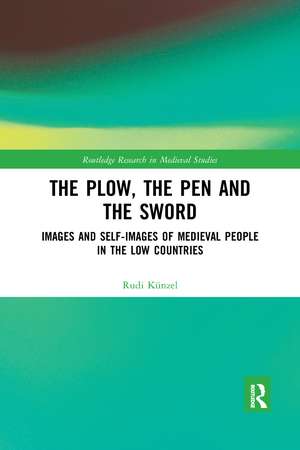The Plow, the Pen and the Sword: Images and Self-Images of Medieval People in the Low Countries: Routledge Research in Medieval Studies
Autor Rudi Künzelen Limba Engleză Paperback – 30 iun 2020
| Toate formatele și edițiile | Preț | Express |
|---|---|---|
| Paperback (1) | 258.06 lei 6-8 săpt. | |
| Taylor & Francis – 30 iun 2020 | 258.06 lei 6-8 săpt. | |
| Hardback (1) | 1000.27 lei 6-8 săpt. | |
| Taylor & Francis – 25 sep 2017 | 1000.27 lei 6-8 săpt. |
Din seria Routledge Research in Medieval Studies
- 26%
 Preț: 765.01 lei
Preț: 765.01 lei - 17%
 Preț: 296.19 lei
Preț: 296.19 lei - 15%
 Preț: 259.31 lei
Preț: 259.31 lei -
 Preț: 391.61 lei
Preț: 391.61 lei -
 Preț: 362.64 lei
Preț: 362.64 lei -
 Preț: 409.31 lei
Preț: 409.31 lei - 22%
 Preț: 258.15 lei
Preț: 258.15 lei -
 Preț: 480.83 lei
Preț: 480.83 lei -
 Preț: 389.38 lei
Preț: 389.38 lei -
 Preț: 434.25 lei
Preț: 434.25 lei -
 Preț: 416.22 lei
Preț: 416.22 lei -
 Preț: 384.48 lei
Preț: 384.48 lei -
 Preț: 387.38 lei
Preț: 387.38 lei - 19%
 Preț: 268.02 lei
Preț: 268.02 lei -
 Preț: 385.25 lei
Preț: 385.25 lei -
 Preț: 391.40 lei
Preț: 391.40 lei -
 Preț: 385.54 lei
Preț: 385.54 lei -
 Preț: 391.40 lei
Preț: 391.40 lei -
 Preț: 389.29 lei
Preț: 389.29 lei -
 Preț: 491.17 lei
Preț: 491.17 lei
Preț: 258.06 lei
Preț vechi: 325.49 lei
-21% Nou
Puncte Express: 387
Preț estimativ în valută:
49.40€ • 53.67$ • 41.52£
49.40€ • 53.67$ • 41.52£
Carte tipărită la comandă
Livrare economică 21 aprilie-05 mai
Preluare comenzi: 021 569.72.76
Specificații
ISBN-13: 9780367594428
ISBN-10: 0367594420
Pagini: 356
Dimensiuni: 156 x 234 mm
Greutate: 0.36 kg
Ediția:1
Editura: Taylor & Francis
Colecția Routledge
Seria Routledge Research in Medieval Studies
Locul publicării:Oxford, United Kingdom
ISBN-10: 0367594420
Pagini: 356
Dimensiuni: 156 x 234 mm
Greutate: 0.36 kg
Ediția:1
Editura: Taylor & Francis
Colecția Routledge
Seria Routledge Research in Medieval Studies
Locul publicării:Oxford, United Kingdom
Cuprins
Introduction Part 1: Group Cultures 1. The Clergy: Self-Image and Ideology 2. Image and Self-Image of the Aristocracy 3. Church Views on Peasants: Cultural Exchange Between the Church and the Peasantry 4. Images of Trade, Merchants, Trade Settlements and Cities Part 2: Exemplary Studies 5. Oral and Written Traditions in the Versus de Unibove 6. Rituals of Humiliation and Triumph: Stavelot, 1065-1071 7. Early Manifestations of Urban Mentalities: Sint-Truiden, Trier and Cambrai, ca. 1050-1150 8. A Tournament of the Dead: Religious Diversity in an Exemplum by Caesarius of Heisterbach. Conclusion.
Notă biografică
Rudi Künzel previously taught in the Department of History at the University of Amsterdam.
Recenzii
‘… this book indeed represents a thought-provoking and insightful collection of studies … it succeeds both in opening up the rich array of medieval sources from the Low Countries and in making accessible the relevant literature based on these sources to international readers. The translation is an excellent piece of work: it follows the Dutch closely but the English is elegant’ - Arnoud-Jan Bijsterveld, Belgisch tijdschrift voor filologie en geschiedenis / Revue belge de philologie et d'histoire
Sample reviews of the original Dutch edition:
‘This is an essential work. For anyone who works on the culture of the earlier Middle Ages, it is indispensable’ - Early Medieval Europe
‘Künzel’s research is the first attempt in Dutch to integrate anthropological concepts and medieval learning ... In my opinion this book, fascinatingly written, merits translation into several languages. It constitutes a wonderful example of detailed analysis, yet striking in the broad richness of the ideas expressed’ - Francia
‘Leaning on a broad theoretical apparatus engaging the most recent methods and problems raised in historical anthropology, Rudi Künzel has made an important contribution to this field ... Overall, Künzel has demonstrated brilliantly that ideological and cultural systems are equally determining as economic forces’ - Cahiers de Civilisation Médiévale
‘This book offers a rich and fascinating kaleidoscope of outlooks of medieval people … compulsory reading for everybody interested in historical anthropology’ - Millennium
Sample reviews of the original Dutch edition:
‘This is an essential work. For anyone who works on the culture of the earlier Middle Ages, it is indispensable’ - Early Medieval Europe
‘Künzel’s research is the first attempt in Dutch to integrate anthropological concepts and medieval learning ... In my opinion this book, fascinatingly written, merits translation into several languages. It constitutes a wonderful example of detailed analysis, yet striking in the broad richness of the ideas expressed’ - Francia
‘Leaning on a broad theoretical apparatus engaging the most recent methods and problems raised in historical anthropology, Rudi Künzel has made an important contribution to this field ... Overall, Künzel has demonstrated brilliantly that ideological and cultural systems are equally determining as economic forces’ - Cahiers de Civilisation Médiévale
‘This book offers a rich and fascinating kaleidoscope of outlooks of medieval people … compulsory reading for everybody interested in historical anthropology’ - Millennium
Descriere
In the Early Middle Ages, clergy, nobility, peasants and townspeople in the Low Countries showed greatly varying attitudes to labor, property, violence, social inequality, religion and emotions. This book analyzes and compares these different group attitudes, which resulted in strikingly contrasting self-images and images of other groups.
